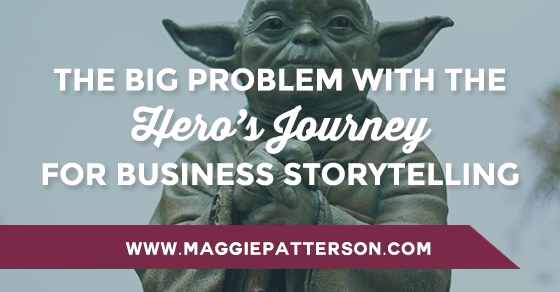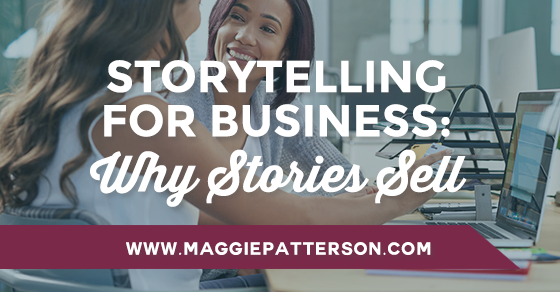 If you’ve studied or read about storytelling at all, you’ve probably heard of what’s called the Hero’s Journey.
If you’ve studied or read about storytelling at all, you’ve probably heard of what’s called the Hero’s Journey.
Never heard of it? Not to worry. If you’ve seen the original Star Wars Trilogy, you get the concept. (See also: Lord of the Rings, The Matrix, and the movie I went on my first date to see, The Goonies.)
The Hero’s Journey, or the monomyth, was developed by Joseph Campbell and is a basic pattern of storytelling that is found in narratives from around the world. It’s essentially the universal story or myth, as it shows up across eras, cultures and geographies.
He wrote about it in his book, The Hero with a Thousand Faces, and described it this way:
A hero ventures forth from the world of common day into a region of supernatural wonder: fabulous forces are there encountered and a decisive victory is won: the hero comes back from this mysterious adventure with the power to bestow boons on his fellow man.
Epic Business Stories with Yoda
Hello, Luke, Yoda and Darth. The Hero’s Journey, while universal, is an epic tale—which is why it takes three movies for Luke’s whole arc to play out. George Lucas actually wrote Star Wars using Campbell’s work and considered him a friend. (If you want to geek out with storytelling plus Star Wars, this video and visual breaks down the Hero’s Journey in the trilogy.)
The very epic nature of The Hero’s Journey makes it problematic for most for us as marketers. Relying on this type of story assumes we have the full attention of our audience as well as the content to make it work.
What if you don’t actually have a strong enough story with all the twists and turns of the Hero’s Journey? Your story falls flat and ends up trying too damn hard. You become yet another person sharing their “I quit my job” story, which is so so SO tired.
Is Your Audience Going to Stick it Out?
The reason the Hero’s Journey works and is the go-to is because it captures our attention and pulls us along for the ride. Plus, it’s the type of story we’re all conditioned to expect, thanks to novels and Hollywood.
The Hero’s Journey has 12 distinct steps:
- Ordinary World: This is the hero in their everyday life, before the adventure starts.
- Call to Adventure: Something happens to our hero and the adventure starts.
- Refusal of the Call: The hero tries to refuse the adventure out of fear.
- Meeting with the Mentor: The hero meets a mentor, who gives them guidance and prepares them for the journey ahead.
- Crossing the First Threshold: The hero sets out for the adventure and crosses the threshold.
- Tests, Allies, Enemies: The hero is faced with the rules of the new world and during the process their strength is tested and they meet friends and foes.
- Approach: The hero has a setback and tries a new approach or idea.
- Ordeal: The hero is challenged with a massive obstacle, potentially a life/death situation.
- Reward: After surviving the ordeal, the hero meets their goal.
- The Road Back: The hero sets out on the road back to their regular life.
- Resurrection Hero: The hero faces the final test before returning to their everyday life.
- Return with Elixir: The hero returns to the ordinary world and brings back the “elixir” to help everyone else.
When it comes to your storytelling, do you think your audience has the time or inclination to sit through the equivalent of The Star Wars Trilogy to build the know-like-trust factor?
Unless you’ve got the charisma of a cult leader or Yoda is your business coach, it’s not likely to happen. People are busy and you’re just one more voice clamouring for their attention.
[Tweet “Are you Luke Skywalker? No? Then stop turning your story into an epic trilogy, says @magspatterson”]
Deconstructing the Hero’s Journey for Business Storytelling
One of the big problems outside of the epic nature of The Hero’s Journey for business storytelling is that, in many ways, these types of stories are not relatable.
We see several themes played out again and again as people tell these stories, a few of which you may recognize: the rags to riches story, the overnight success story, and the “I quit my job and you should, too” story.
Are these inspirational? Totally.
But if this story is the only one you’re telling, you’re missing the mark because you’re making it all about you. You’re not answering “what’s in it for me” for your audience.
There are so many ways to tell stories in your business, but if you’re going to use the Hero’s Journey, deconstruct it so you’re not telling an epic story, but a much more bite-sized one.
Every one of the 12 steps of The Hero’s Journey could give you the jumping off point for stories to share in your business.
Here’s a few prompts to get you going:
- Ordinary World: What was your life like before you started your business?
- Call to Adventure: Why did you start a business? What was the turning point?
- Meeting with the Mentor: Who inspired you? What mentors did you have?
- Tests, Allies, Enemies: What roadblocks have you faced? What roadblocks do you help your customers overcome?
- Return with Elixir: What have you learned? How does that help your clients? Why do you get them?
Take these within the context of the bigger story of your business and how you help your clients, how you serve your community, how you are using what you know to make a difference, and why that matters.
Most of all, just start sharing stories. Storytelling is an art, so you never know what will be the thing that grabs your audience’s attention.
If you want more prompts for storytelling, check out The Storytelling Shortcut, a fun and fast guide to help you find story ideas you can use starting now in your business.
[Tweet “Try bite-sized stories instead of the Hero’s Journey for your biz storytelling. New post from @magspatterson”]


